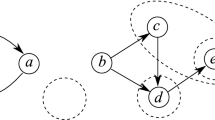Abstract
The system GLS, which is a modal sequent calculus system for the provability logic GL, was introduced by G. Sambin and S. Valentini in Journal of Philosophical Logic, 11(3), 311–342, (1982), and in 12(4), 471–476, (1983), the second author presented a syntactic cut-elimination proof for GLS. In this paper, we will use regress trees (which are related to search trees) in order to present a simpler and more intuitive syntactic cut derivability proof for GLS1, which is a (more connectively and inferentially economical) variant of GLS without the cut rule.
Similar content being viewed by others
Notes
Stemming from one of the meanings of the word “regress,” which is “The reasoning involved when one assumes the conclusion is true and reasons backward to the evidence.”
One reason we use this notation is to avoid confusion with the expression Γ ⊢ Δ which sometimes is a short for “the sequent Γ ⊢ Δ is provable,” which might not be true since Γ,Δ can be any sets of formulas whatsoever. This notation also serves to indicate that the context is of regress trees and not of the (corresponding) Gentzen proof system.
For example, if the root is
 we can use the GLR regress rule to regress it to
we can use the GLR regress rule to regress it to
 or to regress it to
or to regress it to
 (and therefore
(and therefore
 has at least two associated regress trees).
has at least two associated regress trees).Technically, S 1 and S 3 are not in the right form to allow a legal application of the (→ -left) rule; however, they can easily be weakened and strengthened to the right form, thus allowing us to obtain S 4. This remark will apply to all the following instances involving a similar “illegal” use of the (→ -left) rule.
References
Borga, M. (1983). On some proof theoretical properties of the modal logic GL. Studia Logica, 42, 453–459.
Goré, R., & Ramanayake, R. (2008). Valentini’s cut-elimination for provability logic resolved. In Advances in modal logic’08 (pp. 67–86).
Kleene, S.C. (1967). Mathematical Logic. New York: Wiley and Sons.
Löb, M.H. (1955). Solution to a problem of Leon Henkin. Journal of Symbolic Logic, 20, 115–118.
Sambin, G., & Valentini, S. (1982). The modal logic of provability. The sequential approach. Journal of Philosophical Logic, 11(3), 311–342.
Sasaki, K. (2001). Löb’s axiom and cut-elimination theorem. Academia Mathematical Sciences and Information Engineering Nanzan University, 1, 91–98.
Solovay, R. (1976). Provability interpretations of modal logics. Israel Journal of Mathematics, 25, 287–304.
Troelstra, A.S., & Schwichtenberg, H. (2000). Basic proof theory, 2nd Ed. New York, NY, USA: Cambridge University Press.
Valentini, S. (1983). The Modal Logic of Provability: Cut-Elimination. Journal of Philosophical Logic, 12(4), 471–476.
Acknowledgements
I would like to thank David Schwartz for his guidance and great insights.
Author information
Authors and Affiliations
Corresponding author
Rights and permissions
About this article
Cite this article
Brighton, J. Cut Elimination for GLS Using the Terminability of its Regress Process. J Philos Logic 45, 147–153 (2016). https://doi.org/10.1007/s10992-015-9368-4
Received:
Accepted:
Published:
Issue Date:
DOI: https://doi.org/10.1007/s10992-015-9368-4





 we can use the GLR regress rule to regress it to
we can use the GLR regress rule to regress it to
 or to regress it to
or to regress it to
 (and therefore
(and therefore
 has at least two associated regress trees).
has at least two associated regress trees).